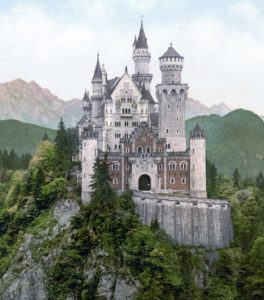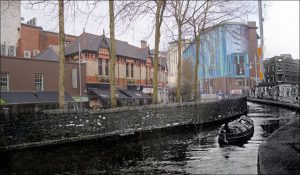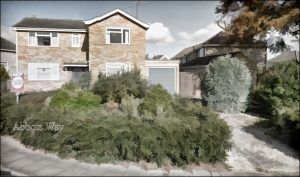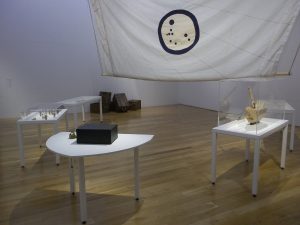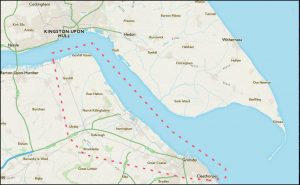Networking in common
(To get information on each figure click on the numbered URLs)
“Public space is a place of social interaction as well as key for the identity and landscape of the city. As a common good, it belongs to all inhabitants and it has a systemic relation with other common goods such as culture or education”.
1 Open commons
Fig 1 URL1
In 2016 the international art competition Artes Mundi selected ‘Seed Journey’, produced by the collective known as Futurefarmers, for inclusion in the short list of six art works, which were displayed in the National Museum of Wales (Fig 1).
Futurefarmers is interested in using art as a vehicle to encourage preserving ‘the commons’ which are globally defined as land use, biological matter and the sharing of knowledge. The ‘Global Commons’ refers to resource domains or areas that lie outside the political reach of any one nation State. Seed Journey connects up these commons through the voyage of the seed carrying vessel Christiania. Its mission is to return historically important packages of rediscovered cereal seeds from Europe to the Middle East, where they were first selected and handed on from farmer to farmer so initiating the neolithic revolution. This retro-voyage touching on all three commons has become a “laboratory” where the collective continues its research into accessing the global commons. In this context, the Artes Mundi installation of Futurefarmers became an interactive “base camp” and visitors were invited to become part of the journey and to consider the possibility of working in common to promote local social change and different futures. Therefore, Seed Journey can be seen as a gesture towards the relatively recent cultural departure of humanity from self-sufficiency and the ecological loss of local genetic controls on plant breeding. However, in a wider scheme of cultural ecology ‘Seed Journey’ can be viewed as an experiment in the development of ‘open commons’ for living sustainably in the context of free trade and consumer capitalism spreading the rule of law, the enhanced use of critical reason, the expansion of individual freedom and the tolerance of diversity. The big question is how to turn the progressivist rhetoric about decent housing, efficient healthcare systems and better schools into cosmopolitan unity through intensified commerce and free access to digital media and computer networking.
Open commons is a term that is unique throughout Europe. It encompasses all types and aspects of digital common property. Urban development in the context of open commons can inspire more participatory governance through the creation of digital cultures that provide knowledge about our existence as inhabitants of cities and as citizens of the world. We all need to learn about the past of our living space, so that we can “own” it and propel this identity and local knowledge into the future. In particular local digital cultures based on open commons allow citizens to gain ownership of the urban environment, and to meet and learn from one another. In short, a culture of open commons in the context of placemaking is a means through which citizens feel they have an interactive niche in the humanised urban ecosystem. This kind of culturally sensitive approach to IT can counter tribalism and empower marginalized individuals and communities to participate in social and political life. In other words, organizations and movements built on digital media and led by citizens strengthen and leverage capacities for collective empowerment and action that can shape politics, not just policy.
However, social media users who can claim to have hundreds of friends in their network, sometimes find it difficult to name half a dozen people that they have actually met in their local neighbourhood. While social networks have helped people to meet like-minded contacts online, they have had a more limited role in developing face-to-face place bonding in communities. But gradually, social networks are beginning to have a bigger role in building community connectedness on the ground and catalysing neighbourhood co-operation and social action.
2 Meeting places
Connectedness has to be the key to living a full and rounded life. The concept is much larger than family. Modern physics recognizes the whole universe as a web of dynamic relationships of which humans are but a tiny outcome. It is within this grand cosmic perspective that a capacity to signal out special places to make connections was crucial to launch the primal social order of indigenous peoples. In a practical sense, choosing meeting places to make connections with nature and others is part and parcel of healing the fundamental disease of our time – the fragmentation of the world and knowledge about it into isolated parts. Piecemeal knowledge is not useful at a time when the real task is to understand and redress the extensive destruction of the life systems of planet Earth brought about by human single- mindedness.
By putting ourselves in the perspective of the rest of reality, human self- consciousness enables us to discover the humiliating truth that the entire world does not revolve around us as human beings, and never has. The moment of recognition comes when we realize that for almost all of geological history, humankind has not existed and has thus been irrelevant to the rest of the universe. If in addition we begin to see ourselves, not just as other people see us, but as all the other species of the natural world view us, as just another animal relative, we suddenly find ourselves in a very broad biological perspective. From a religious viewpoint, this recognition of our real place in a big scheme of things, where our uniqueness is only that we make stuff and accumulate it provides a dramatic moment of humility and of possible conversion to a way of thinking about ourselves as part of the body of the universe, showing reverence to all life. Above all, we belong to places and places do not belong to us (Fig 2).
Fig 2 URL2
This blog addresses the three vital ties to place that give our days meaning. They focus on places in the present where we can make connections with our ancestors and fit these people in the wider context of global history and the cosmos. For example there are:-
Places of landing.
We are by nature a migrant species, and we should mark and celebrate our places of arrival and departure.
Places of settlement.
There are some places in every country that have a particular significance for particular groups of people, because their ancestors have built kinship networks.
Places of interaction between peoples
So many of our places of historical encounter are hidden in the landscape, with little more than a sign to point to them, if that. Many of these are places of conflict, telling stories that we need to know to understand grievances that have been handed down from generation to generation, but there are others that symbolize cooperation, productivity and friendship
.Places of sacred significance
Sacred or holy places are found in different cultures, past and present, all over the world. Such places are frequently marked or embellished by architectural structures and art. In most cases, it can be shown that the sacredness of a place is linked in some way to natural objects and features such as trees, stones, water, mountains, caves, and forms in the landscape. It can further be shown that these natural objects and forms lie at the root of the forms and shapes employed to mark or embellish a sacred site. In this context, my religious standpoint in all this is that the development of modern science has made incredible much of the content of traditional belief of religions, based on a supernatural god. Sacredness and spiritualism without God means that the quest for transcendent living is satisfied in nothing else but genetic demand for inner and outer order that evolved the concepts of ‘intelligence’, ‘love’ and ‘free being’. Silence and contemplation are not just for monks and nuns, they are natural functions of human biology.
Then there are the ‘third places’:
The idea of a public, social place outside of home and work has been around for centuries, but it didn’t enter the lexicon as a “third place” until the phenomenon was thoroughly explored by sociologist Ray Oldenburg in his 1989 book, “The Great Good Place.” .
The concept of third places is frequently cited in professional discussions of topics ranging from community and social connections to the importance of place. Separate from first place (home) and second place (work), third places have taken on a new lustre in recent years as companies discover the value of third places inside the office: cafés and casual spaces where employees can sip coffee, tea or even a beer, and connect with colleagues in a relaxed, informal environment.
Third places are face-to-face phenomena. The idea that electronic communication permits a virtual third place is misleading. “Virtual” means that something is like something else in both essence and effect, and that’s not true in this instance. When you go to a third place you essentially open yourself up to whoever is there. And they may be very different from you. If you don’t know your neighbours, you will be suspicious. And if you are suspicious, you will act accordingly. You don’t get neighbourly on that basis. If you spend time with people you’re not going to hate them, it’s just that simple.
Nevertheless, social media users can harness the interactivity and connectivity of social networking sites to create a sense of place in a digital environment. There are people who argue that regularly scheduled Twitter chats can function as digital third places, sites of online sociality that both mirror and deviate from physical gathering sites, such as bars or clubs. Using Oldenburg’s eight characteristics of (built) third places, apply to people who collectively identify with others and collaborate in digital gathering sites supporting the idea that social networking sites offer the potential for continued thinking about the role of third places in developing connectivity online. Moreover, further opportunities for the study of space—both physical and digital—and the study of time as integral components of digitally mediated interpersonal connection.
3 The memory method of ‘location’
Geographical places and their physical features are sites of memory where landscape operates as a storehouse for collective memory (Fig 3). The bonds between place and identity influence our pastimes, our policies and our politics. Bonding memory with place involves the association of emotionally striking memory images within visualized locations. Persons desiring to train this faculty of memory must select places and form mental images of the things they wish to remember and store those images in places of the mind. The aim is that the order of the places will preserve the order of the things, and the images of the things will denote the things themselves. Metaphorically, places and the images are employed respectively as a wax writing-tablet and the letters written upon it.
Fig3 UR3
The ‘method of location’ is a general designation for remembrance techniques that rely upon memorising spatial relationships to establish, spatial order and aid recall. In this technique the subject memorizes the layout of some building, or the arrangement of shops on a street, or a video game, or any geographical entity which is composed of a number of discrete loci. When desiring to remember such a set of items the subject takes a mental ‘walk’ through these loci and commits an item to each one by forming an image between the item and any distinguishing feature of that locus. Retrieval of items is achieved by ‘walking’ through the loci, allowing the latter to activate the desired items.
Improving one’s memory by using imagery is an ancient technique of memorization by an inner writing. Those who know the letters of the alphabet can write down what is dictated to them and read out what they have written. Likewise, learning memory devices, called mnemonics, helps learners recall larger pieces of information. People can then transpose what they have heard as lists, like characteristics, steps, stages, parts, phases, etc. to places and deliver them from memory. In this context, places are very much like wax tablets or papyrus, the images like the letters, the arrangement and disposition of the images like the script, and the delivery is like the reading.’
Recalling a memory inevitably involves the consideration of time passing. In the everyday places of the countryside and city, we may discern texts embedded in scenery that are capable of revealing important truths about society and culture, present and past. Views singled out from a wide topographic context contain subtle clues about the history of the place. Smaller pictures from the original image focus on particular objects, unfolding a story, as if it were written on the land. Old stumps, derelict walls, field undulations and the form of walls and trees, take on new meaning. For example, in a woodland, the age and cause of tree scars and the size of rocks in stone walls tell of past land use, while the variety of tree species and sizes links the site to changing systems of agriculture and industry. Then there is the form and iconography of buildings. Science, storytelling and history come together in a picture using the themes of time, memory and place comparing ‘then’ with ‘now’.
4 Then’ and ‘now’
” Visual thinking is integral; it’s our habit -it’s not just what we do, it’s how we do, it’s how we do everything’ Sophie Smiles, Scriberia
In 2013 Ferris Jabr produced a paper for ‘Scientific American’ entitled ‘The Reading Brain in the Digital Age’ in which he highlighted the fact that most screens, e-readers, smartphones and tablets interfere with intuitive navigation of a text and inhibit people from mapping the journey in their minds. In particular he pointed out that a reader of digital text might scroll through a seamless stream of words, tap forward one page at a time or use the search function to immediately locate a particular phrase—but it is difficult to see any one passage in the context of the entire text. As an analogy, he invited the reader to imagine if Google Maps allowed people to navigate street by individual street, as well as to teleport to any specific address, but prevented them from zooming out to see a neighborhood, state or country.
Although e-readers like the Kindle and tablets like the iPad re-create pagination—sometimes complete with page numbers, headers and illustrations—the screen only displays a single virtual page: it is there and then it is gone. Instead of hiking the trail yourself, the trees, rocks and moss move past you in flashes with no trace of what came before and no way to see what lies ahead, except by bringing up a replacement screen. An understanding of what came before is held in the reader’s memory; an understanding of what comes next requires a map
A map is not just a peek at the future but is a method of gathering, ordering and recording knowledge. In this connection, all maps are to some extent the products of imagination. No map is ever the truly objective description of a place that it purports to be. Every map is shaped – and coloured – by political, cultural and social conditions, and by the personal experience or imaginative projections of its maker. Maps are works of art that can be enhanced by imaginative embellishments, they can show imaginary places, and artists can adapt map iconography to express their ideas and experiences of place. We can truly say that the digital age has promoted the use of mapping tools in their many expressions as amazing tools to record, organise, recall and comment on visual thinking.
In human evolution visual thinking came long before language. An early imperative for all visual beings must have been to compare one place with another in order to select elements of the environment that aided survival. In this process, the memory capacity of hominids probably evolved to compare ‘then’ with ‘now’ as part of keeping records to cope with the need to coperate in large society, increase pro-sociality and reduce defection even among strangers (Fig 4).
Fig 4 UR4
Record keeping, at first by refinement of visual memory, then by transcribing memory in writing, helps to solve the problem of cooperation in ethnically diverse, ultrasocial polities by transcending the limitations of human cognition. Memory systems of reciprocal exchange facilitate the tracking of heterogeneous interactions and storing the information to guide future reciprocal behaviour. They facilitate reputation formation and maintenance in large group living by providing a record of people’s past behaviour and reputational status. Third, they promote the construction, transmission, and maintenance of social norms and associated moral punishments in large groups. Finally, they expedite the creation of increasingly large and salient group identities by standardising, storing, and transmitting identities across previously distinct social groups. An example of this is the Suffolk community wiki which identifies villages, now an homogenised collection of county postcodes, as ancient settlements within an Anglo Saxon tribal area where they were known collectively as ‘ the people of the River Blyth’. In days before maps village and tribal boundaries were seared in the memories of the inhabitants. They now exist in virtual reality .
5 Open commons: Linz
New digital imaginations of the urban environment can transform citizens’ sense of place and sense of self. For example, since 2009, the Open Commons Linz initiative has made available a wide variety of “free” data: geo-data and statistical information having to do with city life, local government, recreation and tourism..
Open commons refers to digital common property that’s freely available to all citizens, who are permitted to use it under certain predefined conditions and without major impediments. The mission of the Open Commons Linz platform is to responsibly provide the general public with access to such digital content—i.e. digitized music, pictures, photographs, videos, data, literature, radio plays and software. The core module is the Linz Open Data initiative that coordinates the process of preparing and making available data produced by government agencies, whereby these data can then be reused free of charge. More than 50 applications of these data have already been developed.
Free WLAN is already available at more than 200 locations in Linz and in all public transport throughout the city. This is designed to facilitate participation in the digital domain and mobile working. Expanding availability is now focusing on squares and parks, community centres, libraries, recreational facilities, swimming pools and other municipal institutions and cultural complexes. Few municipalities in the world provide inhabitants with infrastructure that delivers such comprehensive coverage free of charge. A map and a list of all available hotspots are online at http://hotspot.linz.at .
To enable citizens of Linz to not only consume content but to create and share it the Public Space Server makes 5 GB of Web space available free of charge to all locals—thus, a practical commons of cloud-based data storage. This server also provides free access to applications such as a webmail programme and a convenient way for users to create their own website and participate in open forums.
6 Virtual landmarking
European cities and towns exhibit rising levels of social exclusion and the concept of ‘social innovation’ in urban development, focuses in particular on the processes aimed at countering it. The term ‘social innovation’ has three core dimensions: the satisfaction of human needs (content dimension); changes in social relations especially with regard to governance (process dimension); and an increase in the socio-political capability and access to resources (empowerment dimension). At a grass roots level, the Internet allows social innovation as an interactive form of communication, where any citizen can use social media to communicate with the world in realtime and can actually receive a response, can have a dialogue and have a chat room as a public space to organise a response. A good example is the local history forum about the town of Grimsby and its surroundings, established by a private individual, born and bred in Grimsby, who described himself and his site thus:
Photography is something of a passion although I wish I spent as much time creatively photographing people as I do angling ! Also, art and all things artistic is a great draw and I derive a great deal of pleasure visiting as many galleries and exhibitions in Lincolnshire as possible
Used to work in engineering after serving an apprenticeship. Then became a full-time book dealer selling rare & collectable books. Got involved in building websites, affiliate search engine marketing and contextual ads. Called it a day and went all but retired at the age of 39. Which sees me where I am today – living life simply and only for my own pleasure really. This means I shouldn’t complain – but frequently do on this site.
The site mixes, hopefully, both humour and, dare I say it, some depth. Historical based stuff is clearly more serious though not too ‘dry’ I hope. Other articles are done somewhat tongue in cheek, there’s a lot of irony, some obvious some more subtle – generally it’s self-deprecating, the joke’s on me even if sometimes, superficially, it may not appear so. The site has grown and grown over the years and last year it averaged 1.8 million hits a month! At our height we were experiencing 3million hits a month but it was unsustainable so I deleted a lot of ’stuff’ and steered the site in another direction. It takes quite a bit of managing at times.
If you see me out-and-about or at an event then please do say hello. It’s always a pleasure to meet anybody who visits the site. Do leave a comment and take part, it’s a friendly place and you don’t need to be an expert . . .Which is just as well because I’m not!
Wellow Abbey is an example of one of the site’s topics, which between 2010-15 elicited 129 comments. Its deliberations can still be seen, using the following link. (Fig 5 ).
Fig 5 URL5
The Abbey probably had an important role in the economy of medieval Grimsby. But, there is very little archival material available about its local impact, which no doubt adds to the allure of the topic to amateur historians. Although the geographical site of the abbey, close to the town centre is well known, it is now occupied by a small housing estate built over it in the late 1960s. Indeed, the town has had several makeovers that have been unsympathetic to the town’s built heritage. Through people accessing a local digital commons, Wellow Abbey and its monks live on in a virtual place visualised in the minds of the few on line visitors who have added their comments to the forum and a much larger number of Internet users who have searched the web or stumbled across the forum whilst surfing. New imaginings have been set in motion giving the web participants and viewers a sense of place without depending on a pictorial archive and where there is nothing to see on the ground. The digital arena of the abbey has been expanded by some contributors to the forum to include personal reminiscences of their real life experiences which were associated with the abbey. I can add one of my own, which took place during the Second World War, when a bomb hit 5 Abbey Drive West on the night of 19th August 1940 killing Frederick North aged 55. Visiting the devastation the next day my Aunt Millie Bellamy, who resided in Abbey Road, a few metres away, saw an angel hovering above the crater. So it is that digital memories of place become embedded in virtual reality.
Grimsby, like so many post industrial towns is topographically placeless. For its inhabitants any sense of place comes from within their consciousness. Perhaps we should call this kind of mental visualisation a spirit of place because it is the combination of characteristics that gives some locations a special ‘feel’ or personality. There is a spirit of mystery in a name, like Wellow Abbey emanating from a locus in the built environment. In this situation, environment is not external and the feeling is internal.
As Cooley Windsor says about the flatbread meditations of Futurefarmers:
“Environment sounds external to us, but it is not. ….. There is no space outside of space….Location is based on one thing’s relationship to something else There is no external grid “.
Albert Einstein was the first person to realize that empty space is not nothing. It is now thought that the material universe is embedded in dark matter through which we live and move as part of Earth’s solar system. In this model our place in the universe is but one structural element embedded in a solid cosmos of dark matter. It is our mental processing that positions us in the cosmos.
7 Summary
In the context of the use of IT in Linz, Grimsby and Blything as aids to placemaking, social media is an inherently conversational tool. Its strength lies in its ability set up places in the minds of individuals and to forge new paths of communication and collaboration between them, and between organisations, individuals and nature. Successful use of social media to establish a sense of place therefore depends on the extent to which individuals adopt a dialogical model that recognizes the participatory, collaborative and networked possibilities social media can offer. Social media can be used simply as a new tool for showing pictures sending and receiving email, announcing events and providing information about who you are. But it also contains the potential to move beyond these activities towards new forms of knowledge co-production, cooperation and collective action to establish interactive connections between people and things in the universe.
8 Internet extension references
Strategies for an inclusive city
Social media and heritage in Uganda
Social networks and ecological knowledge
http://library.ifla.org/1460/1/108-namaganda-en.pdf
http://www.cantab.net/users/michael.behrend/repubs/watson_clee/pages/section_2.html
https://www.scientificamerican.com/article/reading-paper-screens/
http://western.edu/sites/default/files/documents/cross_headwatersXII.pdf


